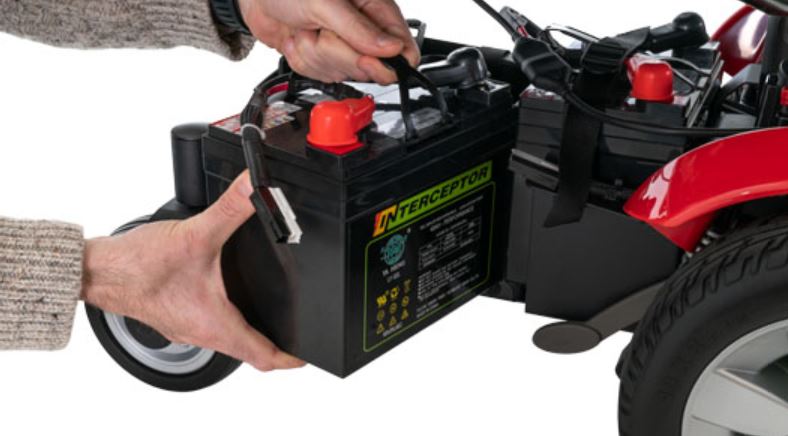What powers your scooter
What kind of charger does a mobility scooter use?
The battery in your Pride Mobility scooter powers your ride, but what powers your battery? All of our scooters are equipped with rechargeable batteries that come with off-board chargers. Just like a cell phone, your scooter plugs into a wall outlet to charge. The energy is then stored in the battery for later use.
First, we’ll lay out the difference between on-board and off-board chargers. We’ll then explore the differences between several off-board chargers. The variations in the battery and charger impact how far your scooter can go.

Off-board vs. On-board chargers
An off-board charger is totally separate from your scooter. This device is a black block with two cords: one that plugs into a wall outlet and one that plugs into your scooter. The size and shape will vary depending on the model.
The wall outlet supplies alternating current (AC) power. AC power moves in waves from power plants into the electrical grid and to your home. Household items that plug into the wall like a fan, microwave or curling iron run on AC power.
Direct current (DC) power cannot travel far distances so it is usually stored in a battery or fuel cell. DC power delivers consistent voltage, making it preferable for electronics like a laptop computer or a mobility scooter.
Your off-board charger collects the AC power from the grid and converts it to DC power. A charged battery is full of DC power that is ready for use.
On the other hand, an on-board charger does that conversion in the device. On-board chargers allow users to plug their device into the wall. The AC power is stored as DC power without an external charging unit.
Are all off-board chargers the same?
No. The battery and charger will differ based on your mobility scooter model. Pride Mobility scooters use chargers that range from 2 to 8 amps. Amps measure the energy rate transferred to a device. The higher the amps, the faster the charge.
At 8 amps, our non-medical Ranger has our fastest off-board charger. It also comes with our biggest battery. The Ranger comes standard with a pair of 75 amp-hour (Ah) batteries. There is an option to upgrade to two 100 Ah batteries.
The bigger the battery, the longer it lasts. Mileage is also impacted by several factors including the weight of the device and its rider. At its 159 kg maximum weight capacity, the Ranger can travel up to 18.6 miles with the 75 Ah battery or up to 39 km with the 100 Ah battery. If the rider weighs 90 kg, the Ranger can travel between 36 and 47 km per charge, depending on the battery.
Models like the Victory 10 DX and Zero Turn 10 use a 3.5 amp, off-board charger. The battery sizes are different, which will change performance. The Victory 10 DX comes with two 40 Ah batteries. This model has a 159 kg weight capacity and an 25 km range. The Zero Turn has two 40 Ah batteries that can travel 42,4 km at its 181 kg limit before needing a charge.
A smaller 2 amp off-board charger is used on models like the Go Go Sport. This travel-ready scooter can cruise 28 km on its dual 18 Ah batteries. The weight capacity of the Go Go Sport is 181 kg.
The Quest also comes standard with a 2 amp, off-board charger. With a 115 kg maximum limit and pair of 12 Ah batteries, this travel scooter can go 20 km before recharging.
The Quest also has a 12 Ah lithium-ion battery option, which can get 16 km on a charge from its 2.5 amp off-board charger.
Lithium-ion technology is advancing quickly and being used in more applications. They hold a stronger current for longer. These batteries are also much smaller and lighter than sealed lead batteries that are standard in all the scooters discussed above. As the Quest shows, a smaller lithium battery provides more juice. Lithium batteries can be charged using on-board and off-board technology. Currently, Pride Mobility lithium-powered scooters use off-board chargers.


